
by Michael Barera
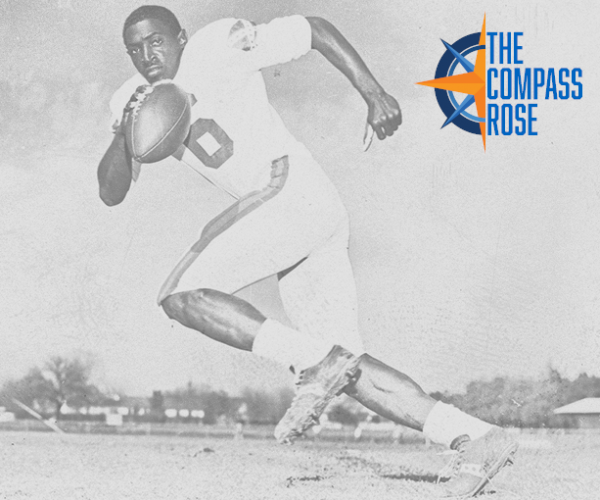

by Michael Barera
The purpose of The Compass Rose is to raise awareness of Special Collections' resources and to foster the use of these resources. The blog series also reports significant new programs, initiatives, and acquisitions of Special Collections.
Listen to the companion podcast on The Archives, "The Starting Line-Up: The First African American Athletes at UTA."
Special thanks to Sara Pezzoni, Photographs Specialist at the UTA Libraries Special Collections, for her extensive efforts locating and digitizing the numerous photographs that illustrate this blog post. Thanks also to Melanie Johnson, Director of the UTA Office of Multicultural Affairs, and KaeLynn Boyd, Graduate Assistant Manager for the UTA women’s basketball team, for inquiring about the first African American student-athlete at UTA last month. It was my research into their question that ultimately resulted in this blog post.
In celebration of Black History Month, this blog post explores the history of the first African American football and men’s basketball student-athletes at the University of Texas at Arlington (UTA). Before delving into this topic, a little bit of background on the university’s segregationist history and its subsequent desegregation is necessary. From its origins as Arlington College in 1895, UTA remained an exclusively whites-only school into the early 1960s. By that time, it was still part of the Texas A&M University System and was known as Arlington State College (ASC). The ASC administration in that era refused to accept African American students, instead referring them to Prairie View A&M University, the only school in the A&M system that accepted people of color at the time (Saxon 1995).
In 1962, prospective students Ernest Hooper, Jerry Hanes, and Leaston Chase III were denied enrollment at ASC on account of race and decided to challenge the college’s exclusionary enrollment policy through legal means. They obtained legal representation from the Dallas branch of the NAACP's Legal Redress Committee and from Dallas attorney Fred J. Finch, Jr. Unwilling to attempt to defend ASC’s segregationist admission policy in court, the Texas A&M University board of directors and Chancellor Marion Thomas Harrington gave ASC President Jack Woolf permission to change the policy immediately, making it the first school in the Texas A&M system to integrate (Saxon 1995). ASC admitted its first African American students in September 1962 (Saxon 1995), but full integration did not happen immediately: athletics teams did not start to be integrated until 1963, while the college’s dormitories and ROTC program were not integrated until 1965 (Saxon 1995) (Barker and Worcester 2015). ASC declared itself “fully integrated” in 1965, but even at that point only 14 of its 61 clubs, fraternities, and sororities had been desegregated (Saxon 1995).
The desegregation of UTA (then ASC) athletics began in 1963. That August, football head coach Chena Gilstrap explained that when the college itself was integrated the previous year, "nothing was said about athletics but now it was just felt that it was time to do so" (Fort Worth Star-Telegram 1963a). While ASC had desegregated in the fall of 1962, that year's football team remained all-white (“Arlington State College vs. Univ. of Southern Mississippi” 1962). An August 1963 Fort Worth Star-Telegram article announced that the 1963 ASC football team would be integrated for the first time, listing four African American student-athletes who were expected to be on the team at the start of fall practice. Those four men were Johnny Jones (from Fort Worth Kirkpatrick High School), Melvin Witt (from Fort Worth Dunbar High School), and Alvin Johnson and Robert Jones (both from Grand Prairie) (Fort Worth Star-Telegram 1963a).
Later in that same article, Gilstrap voiced his expectation that all four of these student-athletes would play on the junior varsity team in 1963, although he did not rule out the chance of them playing varsity. The uncredited author of the article also observed that there was a law in Louisiana forbidding integrated athletics at the time, meaning that these four African American football players would have to sit out those games if they made the varsity squad (Fort Worth Star-Telegram 1963a). By early September, Gilstrap had special praise for two of those players, Jones and Witt, and the Star-Telegram staff paraphrased him as expressing belief that "both should prove valuable" to the team (Fort Worth Star-Telegram 1963c).
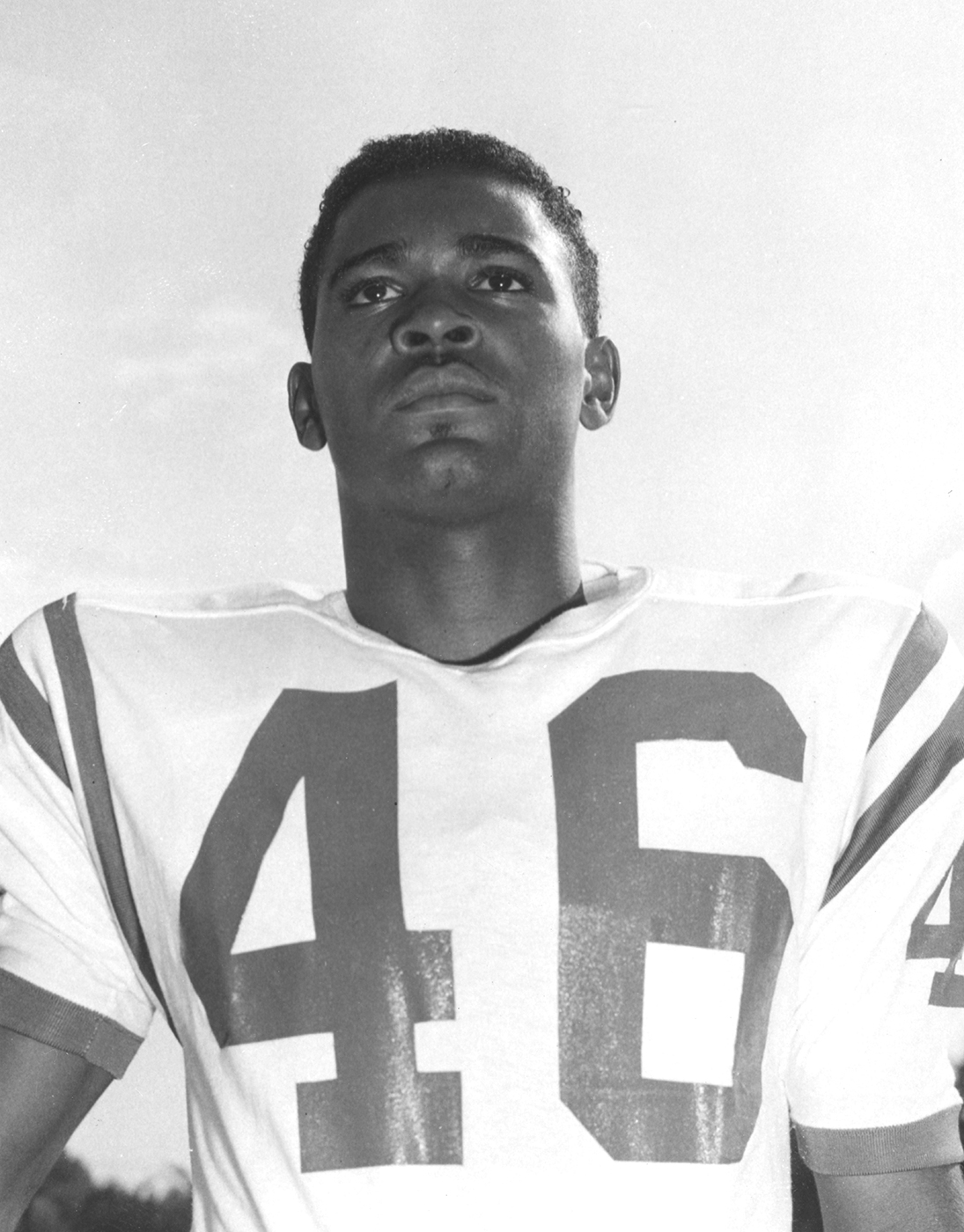
Portrait of Johnny Jones, circa 1963-64
The first African American student-athlete to make the varsity football roster, and the only one to do so in 1963, was Johnny Jones (“Arlington State College vs. Sam Houston State” 1963). Star-Telegram coverage of local high school football in fall 1962 reveals Jones, then a high school senior, was a frequent contributor to the potent Fort Worth Kirkpatrick offense (Fort Worth Star-Telegram 1962a) (Fort Worth Star-Telegram 1962b). According to a retrospective 1981 Star-Telegram article, Johnny Jones even "upstaged" Jerry LeVias when Jones and Kirkpatrick faced LeVias and Beaumont Hebert High School in 1962. LeVias would become famous for desegregating the Southwest Conference, one of the predecessors to the modern Big 12 Conference, when he became the first African American football player at Southern Methodist University (SMU). The 1981 retrospective article also noted that Jones, who disappeared from ASC records and local newspaper coverage of college football after making the 1963 varsity roster, "later attended school in California," but by 1981 his "wereabouts [were] unknown" (Lloyd 1981).
Melvin Witt, the previously mentioned defensive lineman from Dunbar, made the varsity team the following year, 1964 (“Arlington State vs. West Texas State” 1964). A 1966 football program with a list of all football lettermen after ASC attained senior college status (it was a junior college until 1959) reveals that Witt earned a varsity letter in 1964, whereas Jones did not in 1963 (“Tarleton State at Arlington State: Rebel Seniors for 1966” 1966). It is therefore likely that Jones did not play enough (or perhaps at all) to earn a letter in 1963, whereas Witt did play enough in 1964 to earn the distinction. Both thus have a claim to being the first African American football player at ASC: Jones as the first to make the roster and Witt as the first to letter. The Boston Globe and United Press International (UPI) both credited Witt as being the first African American to play for ASC after he was drafted professionally in 1967 (The Boston Globe 1967) (UPI 1967b).
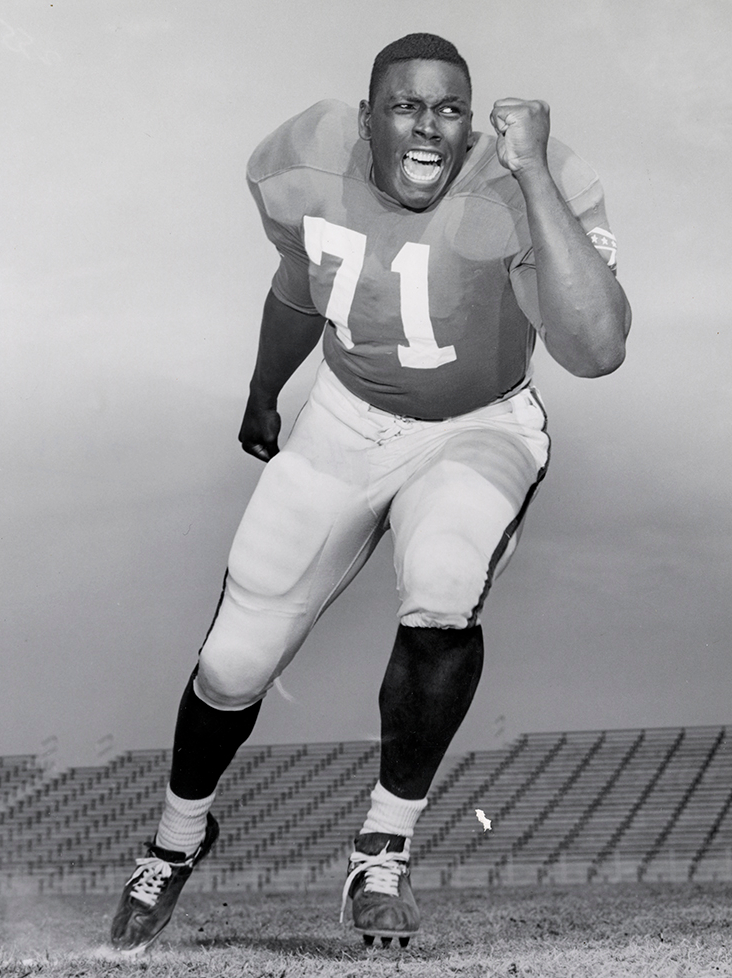
Melvin Witt, 1965
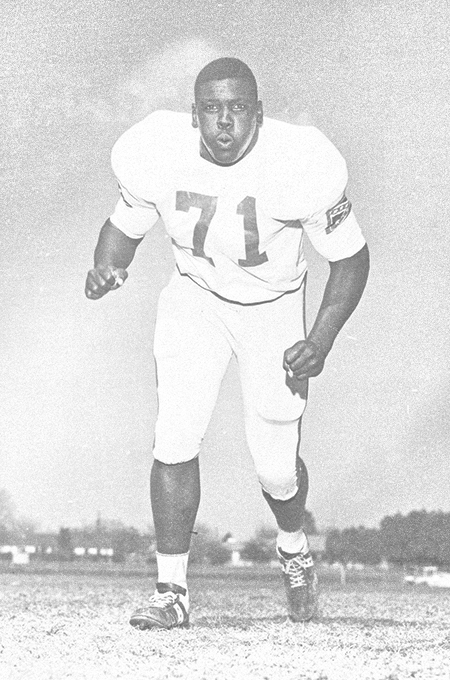
Melvin Witt, 1966
While a senior at Fort Worth Dunbar in fall 1962, Witt was named to the Fort Worth all-city team for African American players (all-city honors were still segregated at that time) as a defensive tackle (Fort Worth Star-Telegram 1962d) (Fort Worth Star-Telegram 1962c). In fall 1963, Roger Summers of the Star-Telegram paraphrased Coach Gilstrap as calling Witt "a good prospect" who "will someday be a big help to ASC" (Summers 1963). Also that fall, Gilstrap was quoted as saying Witt had "fine potential" and was, already at age 17, 6'3" and 220 pounds (Fort Worth Star-Telegram 1963b).
In September 1963, Witt played for ASC's junior varsity team in a game at Henderson County Junior College in Athens (Fort Worth Star-Telegram 1963d). Unsurprisingly for a defensive player, especially a defensive lineman, newspaper coverage of Witt’s on-field accomplishments at ASC is quite limited, especially compared to Carl Williams as a quarterback (see below). However, Bob Wright, in his "Blocks and Tackles" feature in the Mexia Daily News, remarked that Witt was (at 240 pounds) the heaviest player on the ASC squad in spring 1965 and was expected to be a key part of an "excellent defense" in the fall of that year (Wright 1965). After playing primarily as a defensive end in an illustrious athletic career at ASC, in 1974 Witt was named to the Southland Conference "First Decade" team, one of seven UTA players so honored (Fort Worth Star-Telegram 1974). Not only was he one of the best players on the ASC teams of the mid-1960s, he was one of the best players in the early years of the entire Southland Conference.
In spring 1967, Witt was drafted in the fifth round of the American Football League (AFL)/National Football League (NFL) common draft by the Boston Patriots of the AFL (now the New England Patriots of the NFL). A UPI press report at the time quoted ASC head coach Burley Bearden as calling him a "can't miss" pro football player (UPI 1967a). A note in the Star-Telegram observed that the Patriots planned to play him at defensive end, the same position at which he ended his college career (Fort Worth Star-Telegram 1967c), after transitioning from his earlier role as a defensive tackle. Witt ultimately became one of the relatively few UTA alumni to play in the NFL or AFL, playing for the Patriots in both 1967 and 1968 (Fort Worth Star-Telegram 2004).
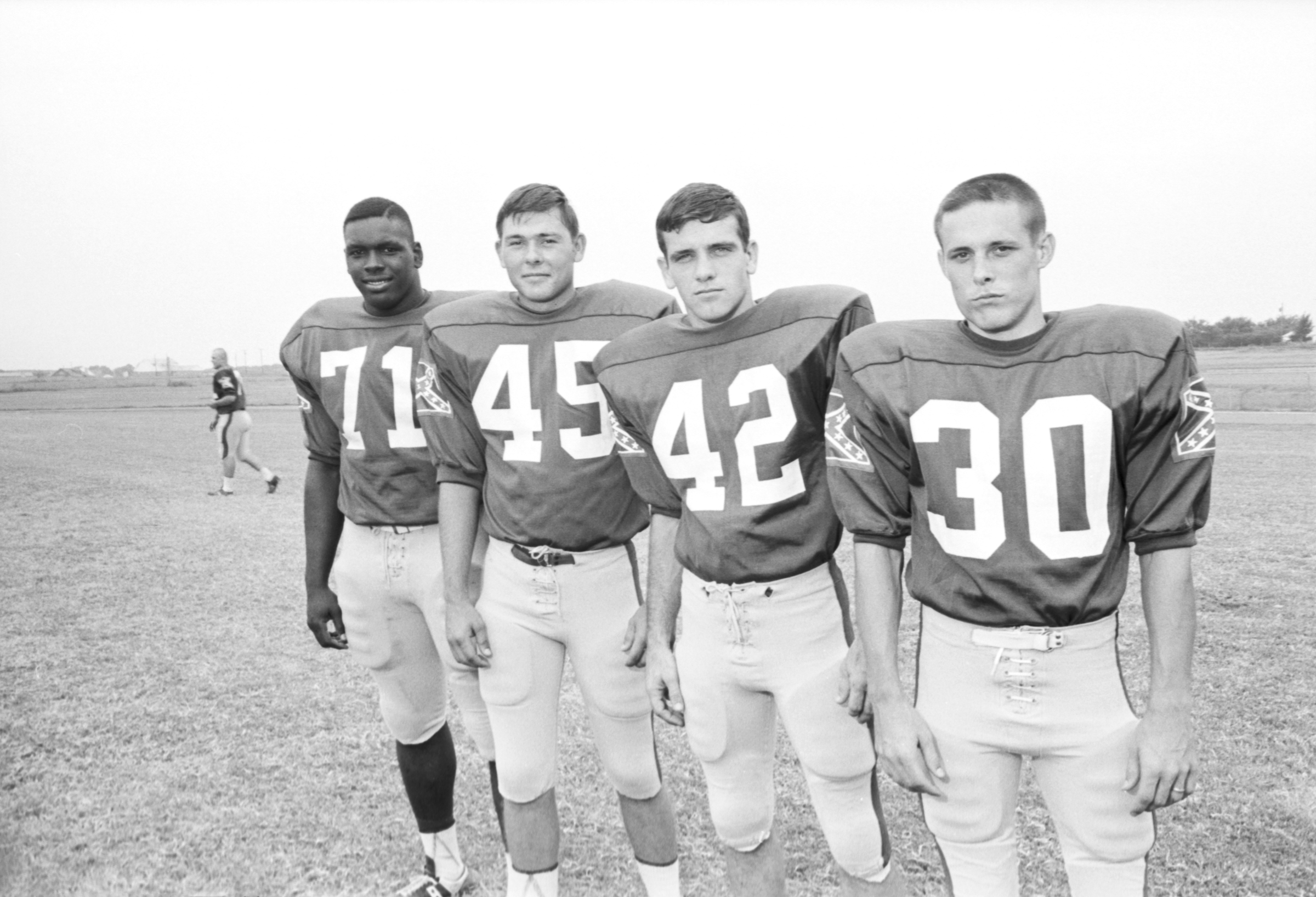
1966 ASC football players (Melvin Witt at left)
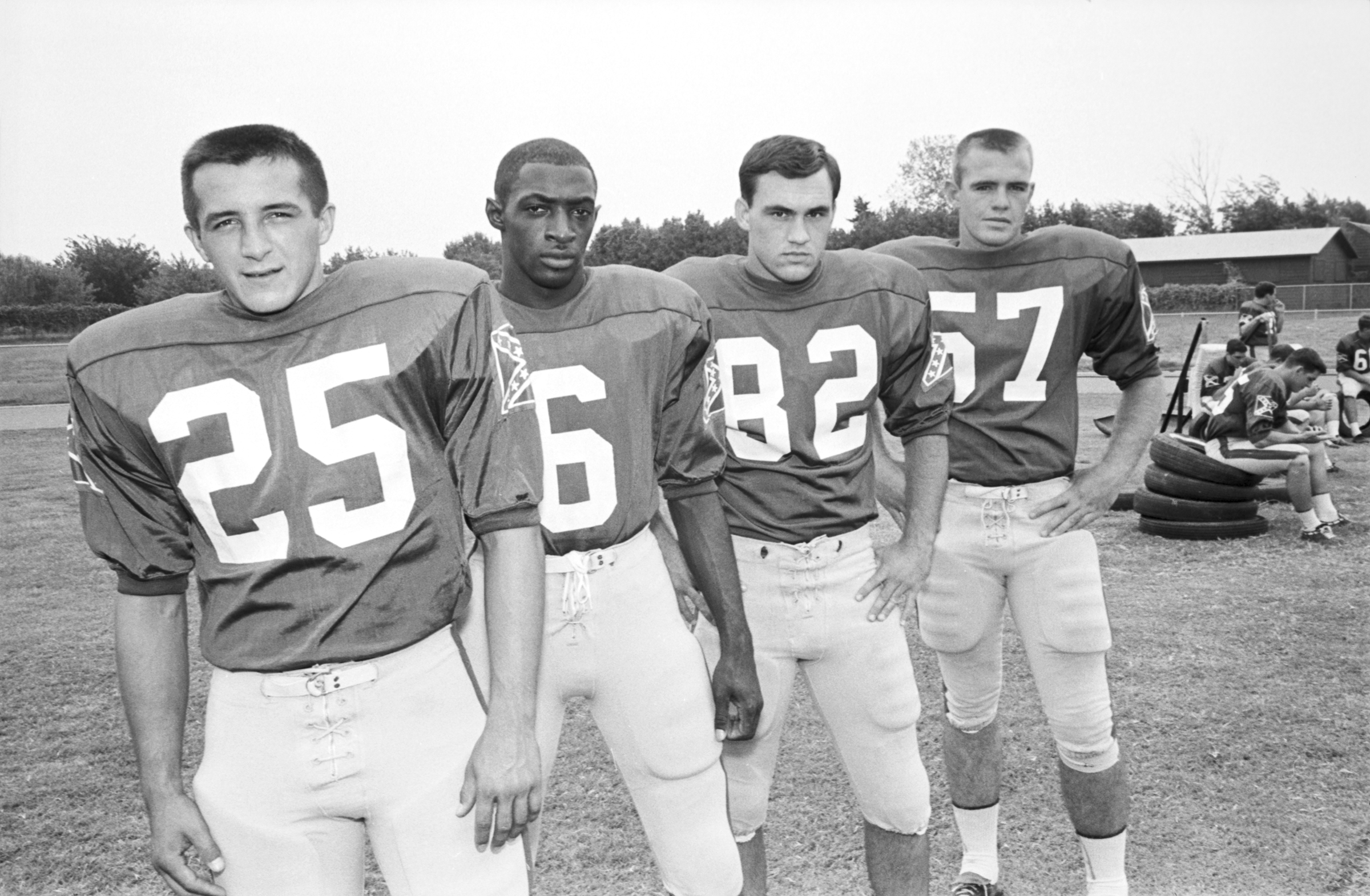
1966 ASC football players (Carl Williams second from left)
Like Witt, future ASC starting quarterback Carl Williams was a high school football star. At Fort Worth Kirkpatrick, he led a potent offense to some particularly impressive victories, including one game in 1963 in which they scored 50 points against Como High School (Fort Worth Star-Telegram 1963e) and, perhaps even more impressively, a 1964 game where they tallied 38 points in a win against previously undefeated Amarillo Carver High School (Fort Worth Star-Telegram 1964b). Williams quarterbacked Kirkpatrick to two straight Texas 3A African American football state championship games his junior and senior years, winning the title the second time, in 1964. He was named to the all-state team both years and was even recruited by two college football powerhouses, the University of Oklahoma and the University of Iowa. Instead, he signed a letter of intent to play at ASC in February 1965. Coach Gilstrap called him "the quarterback we've really been gunning for” and observed that “he has the makings of a great one" (Fort Worth Star-Telegram 1965).
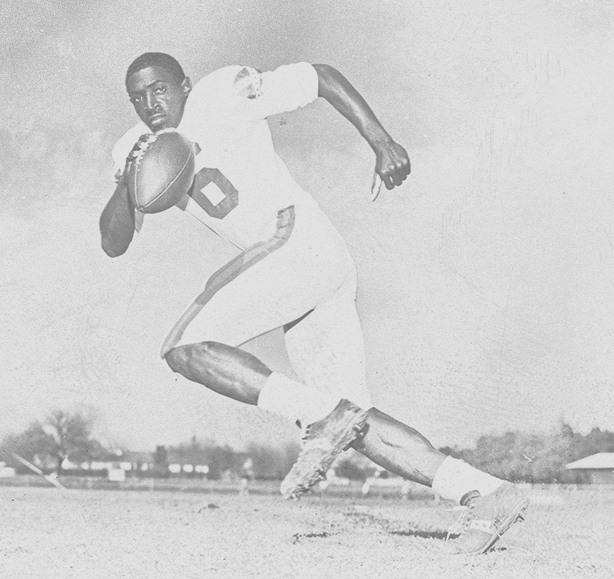
Carl Williams, 1966
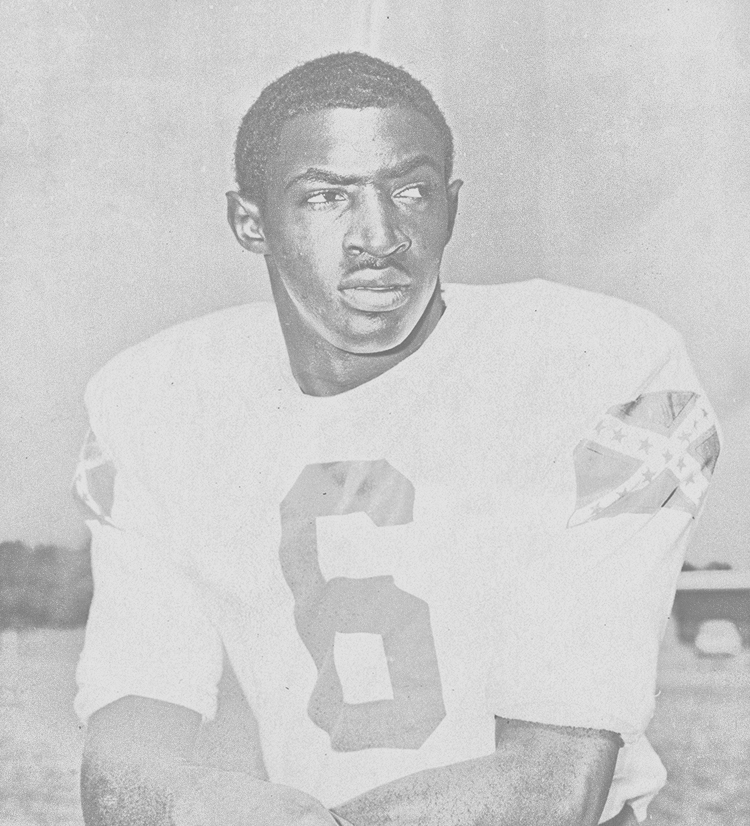
Portrait of Carl Williams, 1966
After leading the first-team offense in ASC's final pre-season scrimmage as a true freshman in fall 1965, Williams secured the starting quarterback duties for the Rebels (UTA teams were not rechristened the Mavericks until 1971) (Grand Prairie Daily News 1965). During the 1965 season, Williams scored 11 touchdowns for ASC in six games played (six passing and five rushing) while compiling 1,231 yards of total offense (Lindley 1966a) (Waggoner 1966). According to Bob Lindley of the Star-Telegram, he "caught the imagination of [ASC Rebels] fans like none other has done in the past decade" (Lindley 1966a). Before a road game in Commerce against East Texas State University (now Texas A&M University-Commerce), opposing head coach Ernest Hawkins called Williams “a threat anytime he touches the ball.” The previous week, he passed for 130 yards and a touchdown and ran for 68 yards and two touchdowns in a 25-7 win over Texas A&I (now Texas A&M University-Kingsville) (Summers 1965a) (Express and News 1965). After leading ASC to a 4-2 record in six games as the starting quarterback, Williams' freshman season was cut short by an injury (Summers 1965b).
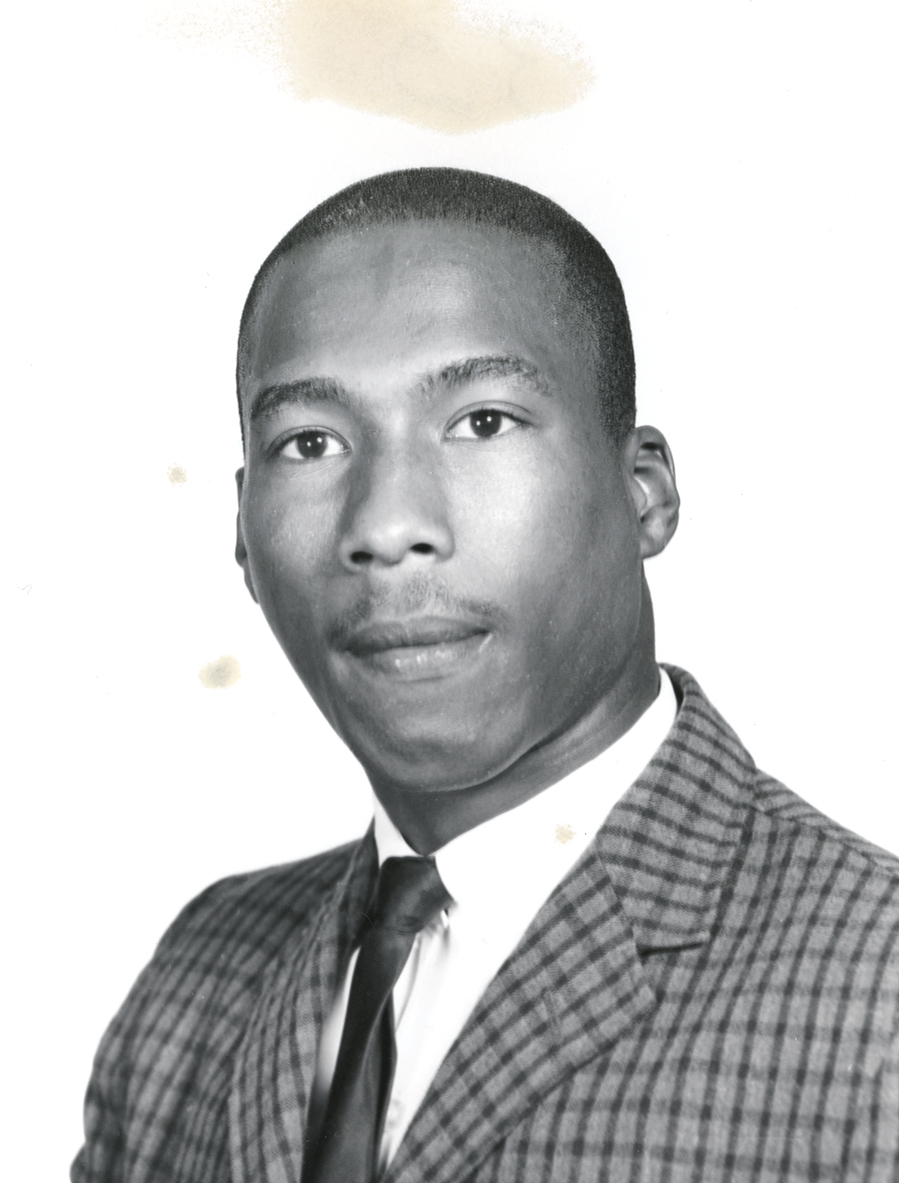
Portrait of Tony Jackson, circa 1964-65
In a preview of a fall 1966 game at Texas Western (now the University of Texas at El Paso), the El Paso Times noted that Williams was a "double threat" who "likes to use the run-pass option.” By that point in the season, he had already accounted for seven of ASC's eight total touchdowns (McKown 1966). One more early African American football player at ASC worth mentioning is Tony Jackson, a running back who played on ASC's JV team in 1964. He scored the Rebels’ only touchdown in a 48-6 loss to Tyler Junior College at home in Arlington that year (Owens 1964). There is no evidence that he played varsity football for ASC in the first three years after desegregation, however.
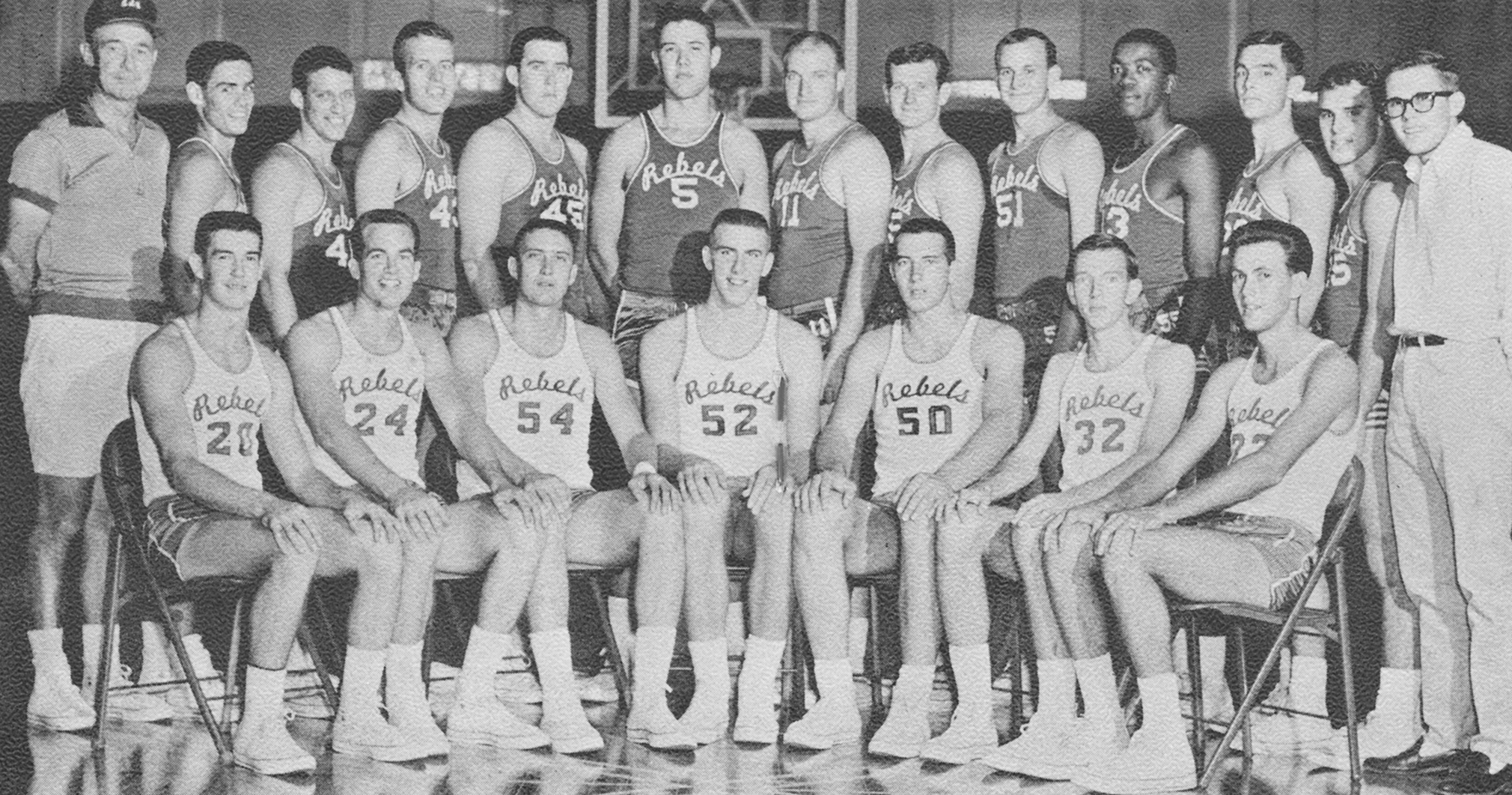
Group photo of the 1964-65 ASC men's basketball team (Larry Allen back row, fourth from right)
Men's basketball at UTA did not integrate as quickly as football, as its 1962-63 and 1963-64 teams remained all-white (“Arlington State College Rebels Basketball Guide 1962-63” 1962) (“Arlington State 1963-64 Rebel Basketball” 1963). The first African American student-athlete to play men's basketball at UTA (still then ASC) was Larry Allen, a freshman who made the 1964-65 team, over a year after Johnny Jones integrated the varsity football roster. Like Jones, Allen came to ASC from Fort Worth Kirkpatrick (“Arlington State 1964-65 Rebel Basketball Press Guide” 1964). The basketball preview that appears in a 1964 football program includes Allen in the team photo but does not specifically mention him in the season preview (“Arlington State vs. West Texas State” 1964). The 1964-65 media guide describes Allen in relatively substantial detail. It noted that he was captain of both the men's basketball and football teams at Kirkpatrick and that he earned all-state honors in both sports. As a high school senior on the basketball team, he led District 1-AAA in both scoring (18.2 points per game) and rebounding (11.0 rebounds per game), averaging a double-double for the season (“Arlington State 1964-65 Rebel Basketball Press Guide” 1964).
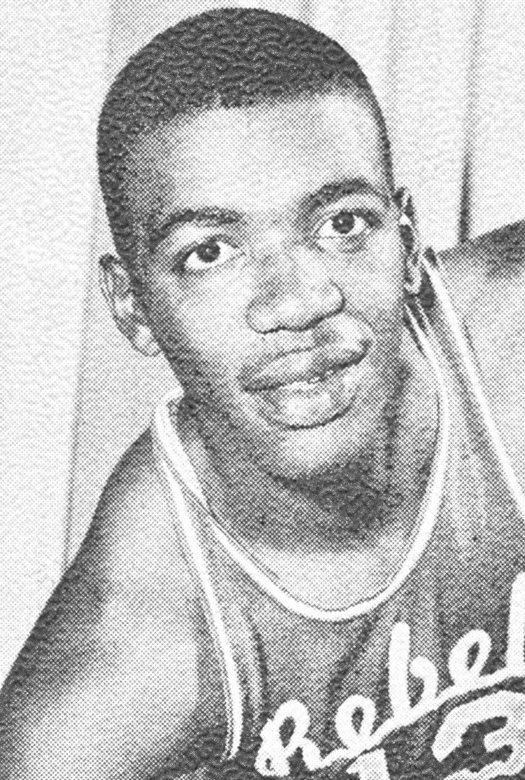
Portrait of Larry Allen, 1964
Local news coverage of high school basketball at the time also confirms that Allen was one of the top players at Kirkpatrick, as demonstrated when he led the team in scoring (with 16 points) in a commanding 75-39 victory over Grand Prairie Dalworth High School in January 1964 (Fort Worth Star-Telegram 1964a). Note that 16 points was less than his scoring average as a senior (18.2 points per game). Observing that he "has excellent moves and good jumping ability but needs to improve his ball-handling and shooting," the 1964-65 ASC media guide predicted he "will probably play on the junior varsity this fall." It also revealed a glimpse into his academic career by mentioning that he planned to major in history at ASC (“Arlington State 1964-65 Rebel Basketball Press Guide” 1964). Like Jones, however, Allen disappears from the records after making the 1964-65 team and was not listed on the roster of the 1965-66 team, indicating that he likely did not play a major role for ASC.
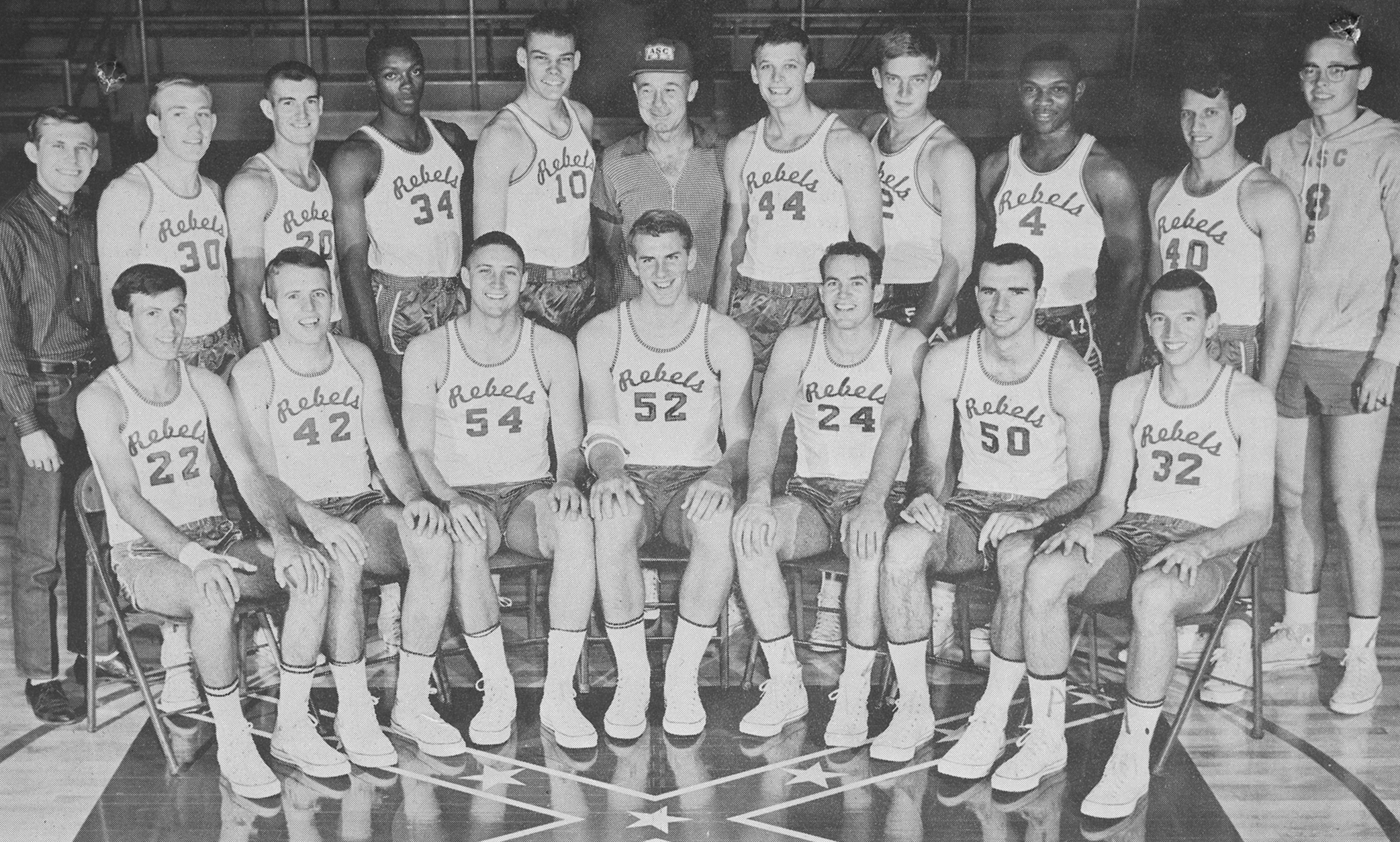
Group photo of the 1965-66 ASC men's basketball team (Huey Saulsberry, back row fourth from left; John Shelton, back row third from right)
However, two African American men's basketball players on the 1965-66 team, Huey Saulsberry and John Shelton, did accomplish much for ASC (and, after its renaming in 1967, UTA) basketball. Both Shelton and Saulsberry were true freshmen, and both had attended Fort Worth Dunbar together. In 1963-64, Saulsberry was one of the top scorers on that high school team (The Austin American 1965). Unlike in Allen’s case the previous year, the 1965-66 ASC men’s basketball preview in a 1965 football program explicitly mentioned both Saulsberry and Shelton (“Arlington State vs. Lamar Tech” 1965). Both played on the 1965-66 team, but only Shelton lettered (Fort Worth Star-Telegram 1967d).
By the 1966-67 season, both Saulsberry and Shelton were frequently starting games for ASC (Fort Worth Star-Telegram 1966b) (Lindley 1966b) (Grand Prairie Daily News 1966) (Fort Worth Star-Telegram 1966a). Shelton was one of the top scorers on that team, scoring in double digits against Tarleton State (Fort Worth Star-Telegram 1967b) and leading the team with 18 points in a game against Lamar Tech (Fort Worth Star-Telegram 1967a). At the end of the season, both were awarded varsity letters: Shelton his second and Saulsberry his first (Fort Worth Star-Telegram 1967d). Shelton and Saulsberry were both frequent starters again in 1967-68 (Fort Worth Star-Telegram 1968a) (Lace 1968). Shelton scored 26 points for UTA against West Texas State (now West Texas A&M University) that year (Fort Worth Star-Telegram 1968b).
As demonstrated here, the question of who the first African American student-athlete at UTA was deserves more than a one-name answer. The simple answer is that the honor should go to Johnny Jones, as the first African American to make the varsity football roster in fall 1963, or perhaps to Melvin Witt, the first African American to earn a varsity letter at UTA while playing on the 1964 football team. But leaving the answer at just that sentence would hide the history of Larry Allen desegregating the men’s basketball team in 1964-65. It would also neglect the remarkable careers of African American student-athletes such as Carl Williams and John Shelton, who just two or three years after their respective teams were desegregated had established themselves as bona fide star players on teams that were still overwhelmingly white. This Black History Month, I would like to take a moment to remember and celebrate their achievements and the legacy they created for so many African American student-athletes who have also since represented UTA in intercollegiate competition.
Bibliography
“Arlington State 1963-64 Rebel Basketball.” 1963. Arlington State College.
“Arlington State 1964-65 Rebel Basketball Press Guide.” 1964. Arlington State College.
“Arlington State College Rebels Basketball Guide 1962-63.” 1962. Arlington State College.
“Arlington State College vs. Sam Houston State.” 1963. Arlington State College.
“Arlington State College vs. Univ. of Southern Mississippi.” 1962. Arlington State College.
“Arlington State vs. Lamar Tech.” 1965. Arlington State College.
“Arlington State vs. West Texas State.” 1964. Arlington State College.
Barker, Evelyn, and Lea Worcester. 2015. University of Texas at Arlington. The Campus History Series. Charleston, South Carolina: Arcadia Publishing.
Express and News. 1965. “Texas A&I Is Jolted,” September 26, 1965.
Fort Worth Star-Telegram. 1962a. “Como to Tackle Terrell Tonight,” September 20, 1962.
———. 1962b. “Crown Captured By Kirkpatrick,” November 17, 1962.
———. 1962c. “Four Given Two Spots On All-City,” December 25, 1962.
———. 1962d. “Kirkpatrick, Dunbar Hog ’Star Honors,” December 25, 1962.
———. 1963a. “ASC Will Integrate Grid Team This Fall,” August 24, 1963.
———. 1963b. “ASC Finds About 90 Candidates,” September 2, 1963.
———. 1963c. “Sophs Bowman, Vaughn Claim Starting Halfback Jobs at ASC,” September 10, 1963.
———. 1963d. “ASC Jayvees Face Opener,” September 18, 1963.
———. 1963e. “Kirkpatrick Rolls Over Como, 50-8,” November 17, 1963.
———. 1964a. “Kirkpatrick Wins,” January 8, 1964.
———. 1964b. “Kirkpatrick Runs Over Carver, 38-0,” November 29, 1964.
———. 1965. “Rebels Sign Negro Star,” February 20, 1965.
———. 1966a. “Bears Set For Rebs’ Invasion,” December 2, 1966.
———. 1966b. “Rebs, Baylor Play Tonight,” December 2, 1966.
———. 1967a. “Rebels Squeeze Past Lamar Tech, 72-71,” January 8, 1967.
———. 1967b. “Rebs Rip Winless Tarleton,” February 2, 1967.
———. 1967c. “Liston Clobbers Bailey in First,” March 31, 1967.
———. 1967d. “11 Rebel Athletes Win Cage Letters,” April 1, 1967.
———. 1968a. “Rebs Open SLC Play,” January 6, 1968.
———. 1968b. “Rebels Win Cage Finale by 100-92,” March 2, 1968.
———. 1974. “SLC Decade Team Lists 7 from UTA,” February 18, 1974.
———. 2004. “UTA Players in the NFL,” August 17, 2004.
Grand Prairie Daily News. 1965. “Frosh May Start For Rebels,” September 14, 1965.
———. 1966. “‘Tom Tinker Night’ Set Tuesday At ASC,” December 6, 1966.
Lace, Bill. 1968. “Scoreboard Due Test in Rebel-Ram Match.” Fort Worth Star-Telegram, January 30, 1968.
Lindley, Bob. 1966a. “Starters OK But Rebels Lack Depth.” Fort Worth Star-Telegram, September 9, 1966.
———. 1966b. “Texas Wesleyan to Challenge Arlington State Cagers Tonight.” Fort Worth Star-Telegram, December 6, 1966.
Lloyd, Bob. 1981. “Roster of Terrell Stars Begins in 1930s.” Fort Worth Star-Telegram, September 13, 1981.
McKown, Rodger. 1966. “Rebels Possibly Underrated.” El Paso Times, October 15, 1966.
Owens, Mack. 1964. “TJC Romps, 48-6.” Tyler Morning Telegraph, October 2, 1964.
Saxon, Gerald D. 1995. Transitions: A Centennial History of the University of Texas at Arlington, 1895-1995. 1st ed. Arlington, Tex: UTA Press.
Summers, Roger. 1963. “Al’s Easy On Shoes.” Fort Worth Star-Telegram, September 26, 1963.
———. 1965a. “Rebs Try To Sneak By Lions.” Fort Worth Star-Telegram, October 2, 1965.
———. 1965b. “Baylor to Replace Ailing Rebel Star.” Fort Worth Star-Telegram, November 2, 1965.
“Tarleton State at Arlington State: Rebel Seniors for 1966.” 1966. Arlington State College.
The Austin American. 1965. “Anderson Topples to FW Dunbar,” January 28, 1965.
The Boston Globe. 1967. “Pats Sign Witt, 3d Draft Choice,” March 31, 1967.
UPI. 1967a. “Boston Signs Mel Witt.” The Courier-Gazette, March 31, 1967.
———. 1967b. “Patriots Sign Mel Witt.” Xenia Daily Gazette, March 31, 1967.
Waggoner, Jerry. 1966. “Kerbel Says Buffs Improve.” The Amarillo Globe-Times, September 14, 1966.
Wright, Bob. 1965. “Blocks and Tackles.” The Mexia Daily News, April 30, 1965.
Add new comment